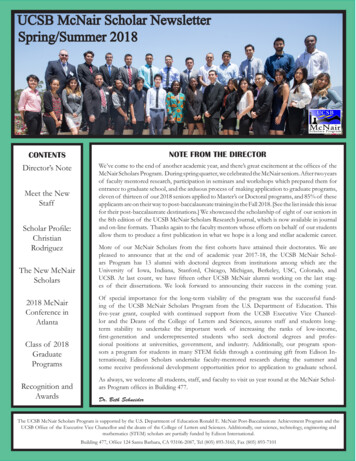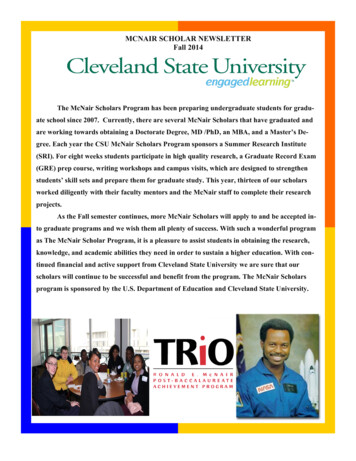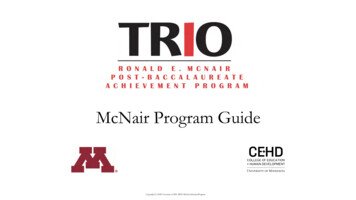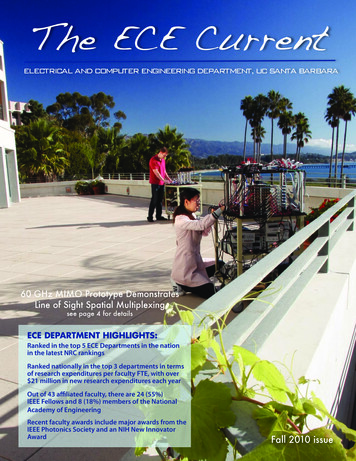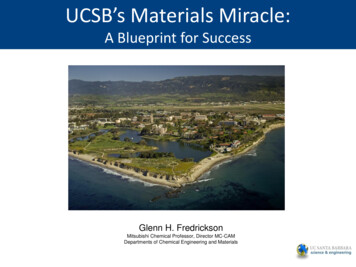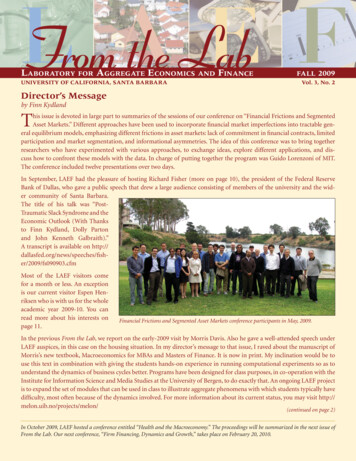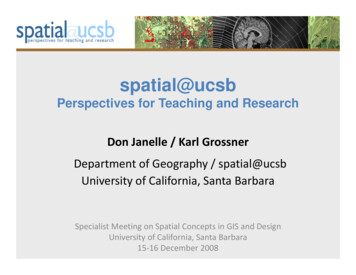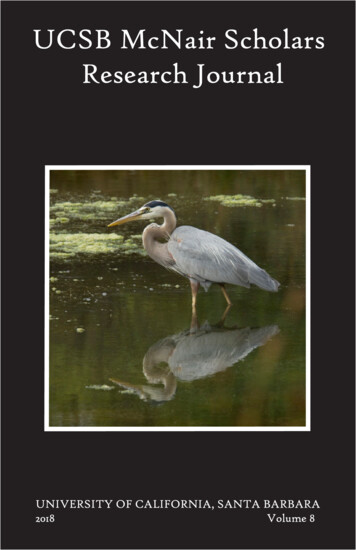
Transcription
UCSB McNair ScholarsResearch JournalUNIVERSITY OF CALIFORNIA, SANTA BARBARA2018Volume 8
UCSB McNair ScholarsResearch JournalUniversity of California, Santa Barbara2018 – Volume 8
Nondiscrimination PolicyThe University of California, in accordance with applicable Federaland State law and University policy, does not discriminate on thebasis of race, color, national origin, religion, sex, gender, genderexpression, gender identity, pregnancy, physical or mentaldisability, medical condition (cancer-related or geneticcharacteristics), genetic information (including family medicalhistory), ancestry, marital status, age, sexual orientation, citizenship,status as a protected veteran or service in the uniformed services.The University also prohibits sexual harassment. Thisnondiscrimination policy covers admission, access, and treatment inUniversity programs and activities. Inquiries regarding theUniversity’s nondiscrimination policies may be directed to:Ricardo A. AlcaínoDirector, Equal Opportunity and Discrimination Prevention Office3217A Phelps HallUniversity of California, Santa BarbaraSanta Barbara, CA 93106-2060(805) 893-4505Cover photos:Tony Mastres, UCSB Photo ServicesiiUCSB McNair Scholars Research Journal
McNair Program StaffProgram DirectorDr. Beth E. SchneiderAssistant DirectorDr. Yvette Martínez-VuProgram CoordinatorGokh Amin AlshaifGraduate MentorsMadeline NolanCruz Ortiz Jr.Gina VanegasWriting ConsultantDr. Ellen BroidyJournal EditorsDr. Beth E. SchneiderDr. Ellen BroidyJournal Layout/DesignMadeline Nolaniii
UCSB McNair ScholarsResearch Journal2018 - Volume 8Table of ContentsMcNair Program Staffp. iiiTable of Contentsp. ivLetter from the Executive Vice Chancellorp. viiLetter from the Interim Dean of Undergraduate Educationp. ixLetter from the Program Directorp. xiLetter from the Journal Editorsp. xiiiFrancisco Olverap. 1Black Middle Class Resistance?: Critical Distancing and theCognizance of Othering in Andrea Lee’s Sarah Phillips andColson Whitehead’s Apex Hides the HurtUCSB Mentor: Dr. Felice BlakeDepartment of EnglishivUCSB McNair Scholars Research Journal
Maria Garcia Garciap. 21Assessing Latinx Adolescents’ Mental Health Using a School WideScreening ToolUCSB Mentor: Dr. Erin DowdyDepartment of Counseling, Clinical and School PsychologyVictoria Melgarejop. 39I Look at People Who Aren’t as Fluent and Think Less of Them”:Language Ideologies of Bilingual and English-Dominant Latinxsin CaliforniaUCSB Mentor: Dr. Mary BucholtzDepartment of LinguisticsNancy Torresp. 63Propane Consumption by Marine Microbial Populations inSeawaterUCSB Mentor: Dr. David ValentineDepartment of Earth SciencesSirenia Sanchezp. 81Is Readability an Open Invitation to Rejection or Solution?: TheEffects of Self-Esteem on Self-Disclosure When Feeling ReadableUCSB Mentor: Dr. Nancy CollinsDepartment of Psychological and Brain Sciencesv
Christopher TurnerCross-Cultural Analysis of Common Markers for PTSDp. 101UCSB Mentor: Dr. Michael GurvenDepartment of AnthropologyJorge MoranRegime Type and Territorial Claims Managementp. 135University of North Texas Mentor: Dr. Paul HenselDepartment of Political ScienceNatalie Bernalp. 154Promoting Parent-Child Interaction Therapy: The Impact ofLanguage and MessengerUCSB Mentor: Dr. Miya BarnettDepartment of Counseling, Clinical and School PsychologyContributorsp. 173Ronald E. McNair Biographyp. 177viUCSB McNair Scholars Research Journal
Letter from Executive Vice Chancellor,David MarshallI am very pleased to introduce Volume VIII of the UC Santa BarbaraMcNair Scholars Research Journal. Named after Dr. Ronald E.McNair Jr., physicist and NASA astronaut, the national McNairScholars Program is a program designed to provide e,andunderrepresented undergraduates with the goal of preparing themfor graduate school. Our local UC Santa Barbara McNair ScholarsProgram supports our campus efforts to advance the diversity andquality of our students, and to prepare them for success beyond theirundergraduate experience. By combining undergraduate researchwith faculty mentoring and academic support services, the McNairScholars Program provides a path to graduate school for studentsfrom families that in the past may not have considered even anundergraduate college education.UC Santa Barbara is very proud to be an Hispanic ServingInstitution. UCSB is the first member of the American Associationof Universities (AAU)—an elite group of the 62 top researchuniversities in North America—to receive this designation. As apublic research university, UC Santa Barbara strives to support allof its students and to give them the knowledge, understanding, andskills to make future contributions to the State of California.The McNair Scholars Research Journal recognizes the researchaccomplishments of a select group of undergraduate scholars froma wide range of disciplines who have successfully completed ourMcNair Scholars Program. Their contributions to this journalrepresent the hard work and intellectual creativity of students who,we expect, will become leaders in their respective fields. In ourprogram, students develop a strong bond with mentors who offerguidance and serve as role models in order to help the studentsrealize their potential. The journal also reflects the contributions ofthe faculty mentors who exemplify the dedication of our campus toundergraduate success.vii
The quality, originality, and creativity of the scholarship publishedhere are very impressive. This research augurs well for the futurecontributions of these students to scholarship and society. Icongratulate the McNair Scholars, applaud their faculty mentors,and extend my appreciation to the staff of the McNair ScholarsProgram for their dedication and work in helping these studentssucceed.David MarshallExecutive Vice ChancellorviiiUCSB McNair Scholars Research Journal
Letter from the Interim Dean of Undergraduate Education,Linda Adler-KassnerUndergraduate research is a “high impact practice,” an activity thatplays an important role in student development and persistence.Participation in undergraduate research has been demonstrated tofoster students’ engagement with research on questions and issuesimportant to them; to create meaningful bonds between students andfaculty mentors; and to lead to production of research that representsnew perspectives.But undergraduate research makes a difference for the institution,too. It provides important venues for the infusion of new knowledge,perspectives, and ideas into departments and even disciplines. Itenables the production of structured opportunities for thosemeaningful connections between students and faculty. And it oftenprovides venues through which new voices and ideas can circulatein the form of journals like this one, which feature student-authoredwork.The eight articles contained in this year’s McNair Scholars researchjournal are a testament to this impact. They come from departmentsacross the university: English, Anthropology, Global Studies,Psychological and Brain Sciences, Environmental Studies,Communication, and Linguistics. This research and theseresearchers are making a difference – at UCSB, in their homecommunities and in their scholarly disciplines. Additionally, theMcNair program (including Director Dr. Beth Schneider, AssistantDirector Dr. Yvette Martinez-Vu, Program Coordinator Gokh AminAlshaif, Writing Consultant Dr. Ellen Broidy, graduate mentors, andfaculty mentors) has made its mark on the UCSB campus, creatingan affirming and supportive environment for students like those inthe program to make these contributions.As Interim Dean of Undergraduate Education in the College ofLetters and Science and a professor of writing studies, it’s mypleasure to introduce readers to the scholars whose work is featuredhere. I take inspiration from their commitment to the questions,ix
ideas, and issues explored in this research. I know that theircontributions will make important differences to others who engagewith these ideas and to the researchers who created them, continuingthe cycle of their work as a high impact practice.Linda Adler-KassnerInterim Dean, Undergraduate EducationProfessor, Writing Studies/UCSB Writing ProgramxUCSB McNair Scholars Research Journal
Letter from McNair Program Director, Dr. Beth SchneiderVolume VIII of the UCSB McNair Scholars Program is now in thehands of our students, alumni, faculty mentors, campus allies, andMcNair colleagues in California and around the country. As theDirector of the McNair Scholars Program since its inception, it is apleasure to showcase the work of eight seniors. Given the recentaward of funding with another five year grant from the USDepartment of Education, all of us and future cohorts of students,can look forward to many more volumes of the UCSB McNairScholars Research Journal.These scholar/authors spent close to two years with the UCSBMcNair Scholars Program. Expectations we hold for the UCSBMcNair scholars are high, and all these students met them,presenting their faculty-mentored scholarship at one McNairScholars National Research Conference or at a professionalconference in their discipline. They each offered two or three postersessions in various venues. This current group of authors not onlypresented their work, but 7 of the 8 applied to graduate school thisyear, and of the seven, all will be attending graduate school in Fall2018 (Boston College, University of Michigan, Stanford University,Northwestern University, University of Southern Florida,University of Chicago, UCLA).The papers published in Volume VIII are the final versions ofmanuscripts our graduates were willing to see through topublication. They went the extra mile, writing and rewriting theirresearch papers in response to a steady stream of comments fromtheir mentors and the journal editors. As undergraduate researchpapers, we expect that these publications will be the first of manymanuscripts published by these eight students during their graduatetraining and in their first academic positions.The eight scholars whose work is featured in this issue displayedperseverance, patience, and diligence that will serve themexceedingly well in their continued professional training. For allfirst-generation, low income, and underrepresented undergraduates,xi
the existence of the journal and the labor it represents will hopefullybe an inspiration to seek research opportunities, develop successfulmentorships, and take seriously a future in which the McNairScholars Program played and continues to play an important part.With special thanks to the UCSB McNair Scholars staff, andcongratulations to the scholars.Beth E. SchneiderProfessor of SociologyDirector, UCSB McNair Scholars ProgramxiiUCSB McNair Scholars Research Journal
Letter from the Editors,Drs. Ellen Broidy and Beth E. SchneiderThe McNair Scholars Program at UCSB is pleased to bring you theeighth volume of the UCSB McNair Scholars Research Journal. Acooperative effort of faculty mentors, McNair staff, and mostespecially a dedicated cadre of student scholars, the journalrepresents months of research, writing, editing and reviewing on thepart of all the participants.For our scholars, preparation of their manuscripts for publication inthe Journal begins as a challenging and ends as a rewardingexperience. Novices when they start the process, the scholarsembark on a year-long adventure in what it takes to produceacademic work suitable for publication. With good humor andextraordinary patience and fortitude, they experience both thefrustration of being asked to revise and revise again and the feelingof elation that comes with a final acceptance. Through this process,the McNair staff sought to provide scholars with a practical handson introduction to the types of writing and revision expected ofgraduate students and academics.Submission to the Journal is not a requirement of participation in theUCSB McNair Scholars Program so we are enormously gratifiedthat a number of our students graduating in 2018 volunteered toallow their work to be put under the editorial microscope. While wewould have liked 100% participation, previous publicationarrangements with faculty mentors meant that some scholars wereunable to submit their work. The scholars who did contributeworked diligently on their papers, rethinking, rewriting,reorganizing, and in some instances, reconceptualizing core ideas inresponse to comments from faculty mentors and the Journal’seditors. We applaud them all for their hard work and commitment.We want to say a special thank you to the faculty mentors whoworked alongside the students to guide them in the production ofsuch high caliber work.xiii
We trust that you will enjoy reading the work of the UCSB McNairScholars represented in this eighth volume of the Journal. We lookforward to bringing you the voices of new generations of scholars insubsequent volumes and thank you on behalf of the authors,mentors, McNair staff, and editors who made this publicationpossibleBest,Ellen BroidyWriting Consultant, UCSB McNair Scholars ProgramBeth E. SchneiderProfessor, Department of SociologyDirector, UCSB McNair Scholars ProgramxivUCSB McNair Scholars Research Journal
Black Middle Class Resistance?: Critical Distancing and theCognizance of Othering in Andrea Lee’s Sarah Phillips andColson Whitehead’s Apex Hides the HurtFrancisco OlveraMentor: Dr. Felice BlakeDepartment of EnglishAbstractFollowing the Civil Rights movements of the 1960’s, a cultural,social, and economic transformation took place within the lives of raciallyoppressed people in the United States. The pathway to a middle-classexistence, through desegregation and social justice, seemed cleared. Thispaper challenges these assumptions of emancipation through aninvestigation of racial and class intersections; and, examines how AndreaLee’s Sarah Phillips and Colson Whitehead’s Apex Hides the Hurtexplore notions of agency and resistance in a post-Civil Rights setting. Inthis paper, I argue that despite the access to economic mobility, raciststructures and constructions of abjection remain steadfast. Furthermore,the authors of these novels depict sentiments of non-belonging throughtheir protagonist’s cognizance of their racial othering. These novels thusoffer an intimate and personal lens through which we can examine nontraditional forms of resistance whereby resistance takes the form ofcritical distancing, a methodology against racial fixity.1
“I loved history as a child, until some clear-eyedyoung Negro pointed out, quite rightly, that there wasno place in the American past I could go and be free.”Sherley Anne Williams, Dessa Rose“But there is also an American Negro tradition whichteaches one to deflect racial provocation and tomaster and contain pain. It is a tradition which abhorsas obscene any trading on one’s own anguish for gainor sympathy; which springs not from a desire to denythe harshness of existence but from a will to deal withit as men at their best have always done. It takesfortitude to be a man and no less to be an artist.Perhaps it takes even more if the black man would bean artist.”Ralph Ellison, The World and the JugResistance to racist oppression has long been a pressingissue in the lives of racially marginalized and oppressed groups andindividuals living in the United States. In the latter half of thetwentieth-century, the Civil Rights, Black Power, and BlackFeminist movements produced powerful critiques of and challengesto the institutions of racism and racial segregation that stifledcollective and individual freedoms. During this time, black peopleand other marginalized communities fought for the recognition oftheir constitutional rights that had previously been denied to themby racist laws, policies and practices. Through the obtainment ofthese constitutional rights, these communities sought the totaltransformation of the social order. The triumphs of their collectivemobilizations for a shift towards racial equality, economicaccessibility, and justice are illustrated by the passing of legislationsuch as the Civil Rights Act of 1964 and the Voting Rights Act of1965.Still, the question remains of whether the rise of the blackmiddle class and the creation of laws on paper were enough toeradicate the corrosive effects of racism. Unfortunately, they were2UCSB McNair Scholars Research Journal
not. The notion that the U.S. is a “post-racial” society, wherediscrimination and injustices based on race have disappeared, is bothuntrue and dishonest. Although those laws, and recently an Obamapresidency, signals such a possibility, “post-raciality” is challengedby the present existences of forces that target racial communities,such as, but not limited to, the prison industrial complex and theexpanding racial wealth gap (Davis). Institutional racism continuesto thrive and stifle freedoms; it does not only depend ongovernmental and political forces, but also on the long history ofracial othering that fixes and signifies blackness as abject (Gates;Spillers). Given the significance of these forces of racism in the livesof black people today, how do we understand a resistance againstthose forces that is grounded in the intimate and internal psyches ofracially oppressed people?African-American literature offers a space for theseinterrogations. Meditating on questions of freedom following the eraof the Civil Rights, Dr. Bertram D. Ashe examines the artisticframework described as the “post-soul aesthetic,” an aesthetic thathe and others correlate with the socio-political shift that themovements for Civil Rights brought forth. Ashe argues that the CivilRights era represents a shift in the paradigm of how black artistsunderstand their relationship to the notion of freedom, and I wouldtherefore argue, resistance (619). One of the archetypes presentwithin the artistic framework of the “post-soul aesthetic” is thecultural mulatto. It is what this archetype enables that is sosignificant for understanding the intimate and internal realm ofresistance to racist oppression: “[the] cultural mulatto troublesblackness inwaysthatdepartsignificantlyfromprevious preoccupations with struggling for political freedom, orwith an attempt to establish and sustain a coherent black identity”(614, emphasis added). The “cultural mulatto” understands theirstruggle to be distinct from that of their ancestors. This differentcognition of what “struggle” is marks a departure that is useful forunderstanding the lives of black individuals whose resistance isrooted in both denying constructions of blackness that see them as3
abject, but also any additional forces that seek to strip them ofautonomy by defining them on terms that they did not set.The “post-soul aesthetic” is limited to black artists who werenot adults during the Civil Rights era (611). Ashe points to astatement made by Dr. Mark Antony Neal that elaborates upon thislimitation where he states that those not of adult age in the CivilRights era, “are in fact divorced from the nostalgia associated withthose successes and thus positioned to critically engage themovement’s legacy from a state of objectivity that the traditionalcivil rights leadership is both unwilling and incapable of doing”(Neal 103). For both Ashe and Neal, there is a strong need to situatethe “post-soul aesthetic” in a post-Civil Rights setting that is distinctfrom the consciousness that informed the Civil Rights’ Black Powermovements. In essence, the Civil Rights era produced a change inhow middle and upper middle class African-Americans understoodand represented themselves in fiction. This novel understanding wasconnected to the legislative accomplishments, but the imaginativespace of fiction allowed for deeper discourses regarding the internalaffects and epistemologies that arise from such a shift in the socialorder. It is in this space where “traditional” methodologies ofresistance to institutionalized racism are “troubled” and provoked.Andrea Lee’s Sarah Phillips and Colson Whitehead’s ApexHides the Hurt can both be considered post-Civil Rights novels. Assuch, these texts are invested in interrogating the meanings oftransforming and emerging freedoms in the context of the outlawingof racial segregation in the United States. Both novels investigatehow the amalgamations of class mobility and racial differencetrouble and shape their protagonists’ understanding of their racialidentity. Lee’s novel centers around the experiences of a youngAfrican-American woman at the apex of and after the Civil Rightsmovement. Whitehead’s novel focalizes an unnamed, blacknomenclature consultant placed in charge of deciding the new namefor the fictional town Winthrop. These two texts illustrate how theprotagonists’ economic privilege does not erase how their racialidentities shape their understanding of themselves, and the world4UCSB McNair Scholars Research Journal
around them. Instead, their economic standing and their racialidentity reveal a form of racist oppression that is portrayed asindividualized given the ways that the protagonists react to itsforces. Analyzing the protagonists’ moments of tension, as well asintrospection, I argue that resistance to racism can also occur as asolitary and internal act, an act of resistance that takes the form ofwhat I posit as critical distancing that is undertaken in relation to,and through, the character’s cognizance of their racial othering. Idefine critical distancing as an affective methodology against racialfixity, but also an epistemological positionality that is hyperawareof interpellations against the racial self.Sarah Phillips and “Escaping”Analyses of Sarah Phillips tend to center around Sarah’sseeming refusal, or inability, to resist the racism and sexism sheencounters. This can make Sarah’s seeming passivity in the face ofthese oppressive forces frustrating at times because readers ofAfrican-American literature expect explicit reactions from her as ablack woman. Because she does not respond as such, she thwartsour expectations of what resistance should look like. For example,in the foreword to the novel, Dr. Valerie Smith notes the discomforther students feel when reading this novel because it does not “centeron a character engaged in a project of political or personalresistance,” essentially troubling their expectations as readers ofAfrican-American literature (Smith, x). On the surface level, SarahPhillips does not appear as a novel concerned with politicalresistance. It shies away from the forms of resistance we oftenassociate with the Civil Rights era, where resisting the institution ofracism emerges in palpable forms such as sit-ins, protests, andmarches.The resistance Sarah Phillips does portray is rooted in theprotagonists’ tensions between her sense of self and the impositionsof her racial identity. This takes the form of a critical distancing thatdisengages her from a predetermined racial and gendered identitywhile at the same time keeping her cognizant of her racial othering.5
When we first meet Sarah living in Paris with a group of young men,one of the first things that she relates is a brief description of whoshe understands herself to be:I had grown up in the hermetic world of the oldfashioned black bourgeoisie—a group largelyunknown to other Americans, which has carried onwith cautious pomp for years in eastern cities andsuburbs, using its considerable funds to attemptpoignant imitations of high society, acting withgenuine gallantry in the struggle for civil rights, andfinally producing a generation of children educatedin newly integrated schools and impatient to escapethe outworn rituals of their parents (4).This passage conveys Sarah’s cognizance of who she is inrelation to the Black middle class. Furthermore, it serves as a selfreflection on Sarah’s part that anticipates the remainder of the firstchapter where her current setting can in fact be read as her personal“escape” from her parents, and from a country. Although Dr.Adrienne McCormick critiques Sarah as a character marked with theinability to understand how she is shaped by the discoursessurrounding her identities of class, race, and gender—an inabilitythat renders her speechless in the face of the racism and sexism sheencounters (812). This reading is misguided because there is aninherent understanding within the initial self-reflection thatdemonstrates Sarah’s cognizance of her position. A cognizance thatsees how the mixture of her economic standing with her racialidentity has rendered her and her family “unknown,” given racistnotions of not associating blackness with wealth. Furthermore, thereis a tone of indifference in this passage that suggests that Sarah hasthought about this position more than once. In essence, Sarah’sinitial reflection shows that she is able to understand how race andclass shape her existence.The real “inability” that Sarah faces is the inability tonegotiate the social position she finds herself in where a relatively6UCSB McNair Scholars Research Journal
sheltered upbringing does little to negate racist constructions ofblackness. This is the conundrum of Sarah’s present existence, andit is made explicit and tense in the first chapter of the novel, titled“In France.” In this chapter, Sarah introduces her “more Frisian[Germanic ethnic group] than French” lover Henri, one of the youngmen she lives with, by stating that when she first met him, “[he] hadjust returned from touring Texas, where he had bought a jauntyConfederate cap” (5). She continues by recounting how Henri wouldcall her “Reine d’Afrique, petite Indienne” and remarking on hisadmiration for Richard Nixon and General Lee. In essence, Henri ischaracterized as a racist. Yet despite the apparent symbols of racialenslavement, and her sexual exoticization and objectification, Sarahdoes not reveal any visible signs of anger or sadness. The onlyemotions such racism invokes in Sarah are “boredom” and“annoyance.” In the first few pages of the novel, blackness istroubled by a character who refuses to even describe what sheexperiences as racism. Although this passage does indeed raisequestions regarding Sarah’s apparent “complicity” in the racism sheencounters, it raises an even more critical question regarding thenon-visible effects of racism, that attack the affective self, and thestrategies employed by a character, like Sarah, who enjoyseconomic wealth. Negating the effects of racism can be understoodas a component of her “escape” that she employs because of herprivilege. This passage ultimately reveals that a physical escape canonly do so much with respect to escaping the construction of herblackness as abject.Towards the end of the “In France” chapter, Sarah is at arestaurant with her lover Henri, and their two other housematesAlain and Roger. They exchange vulgar jokes. At one point, Sarahinsults Henri and he responds by attacking her race, telling her: “thather mother was an Irishwoman, and her father [a] monkey” (11). Hecontinues, saying “her mother was raped by a jazz musician as bigand black as King Kong ” (11). Sarah calls him stupid and leavesfor the restroom. Once again, she refuses to confront the explicitracism she experiences from an intimate partner, a refusal whichleads one to question if her economic affluence has made her7
complacent with privilege to the point where she trivializes whetheror not her race matters to her identity. McCormick reads this sceneas an act of cowardice on Sarah’s part, stating that Sarah “runs awayfrom her accuser and hides in a bathroom” (808). The problem withthis reading, however, is that it neglects the preceding moments ofracism that Sarah did not “run” or “hide” from.This lack of uniformity in how Sarah treats the racism sheencounters negates characterizations of cowardice on Sarah’s part.It is more complicated than simply Sarah fleeing racist attacks. Thisis ultimately evidenced through how she reflects about not feelingupset or hurt by Henri’s racism, that in fact this is how they oftenjoke around with each other. Instead, she states that “his silly talehad done something far more drastic than wound [her]: it hadsomehow illuminated for [her] with blinding clarity the hopelesspresumption of trying to discard [her] portion of America” (12). ForSarah, the racism she experiences does more than “wound” herbecause it fixes her blackness as abject. She recognizes her inabilityto escape her “portion of America,” where wealth, and flight cannoterase all of the negative associations with blackness. The fact thather class status cannot protect her from these constructions is crucialto recognizing the flaws of simple economic accessibility. Sarahgoes on to say that “she felt furious and betrayed by the intensity ofnameless emotion [the racism of Henri] had called forth in [her]”(12). Yes, Sarah “troubles blackness” by refusing to confront racismthrough direct action, but it is not cowardice. Instead, it is an act ofcritical distancing, one that allows her to move beyondunderstanding her race as a defining characteristic. It is one thatchallenges constructions of her blackness as abject by notacknowledging these forces, but still demonstrating a reaction, onefound within spheres of affect and “nameless emotion.”This first chapter, especially the scenes where Sarah isplaced in racist confrontations, challenges our conceptions of howresistance looks because of her seeming ambivalence about herracial identity. Despite Sarah’s ability to travel to Europe and liveher life in economic stability, she cannot escape the constructions of8UCSB McNair Scholars Research Journal
her racial identity that she lives with and is burdened by this reality.The freedom, mobility and access that her economic standing givesher is thus thwarted and undermined by racist constructions ofblackness. In addition to her personal reflection in the bathroomabout discardi
Scholars Program is a program designed to provide research opportunities for first-generation, low-income, and underrepresented undergraduates with the goal of preparing them for graduate school. Our local UC Santa Barbara McNair Scholars Program supports our campus efforts to advance the diversity and
